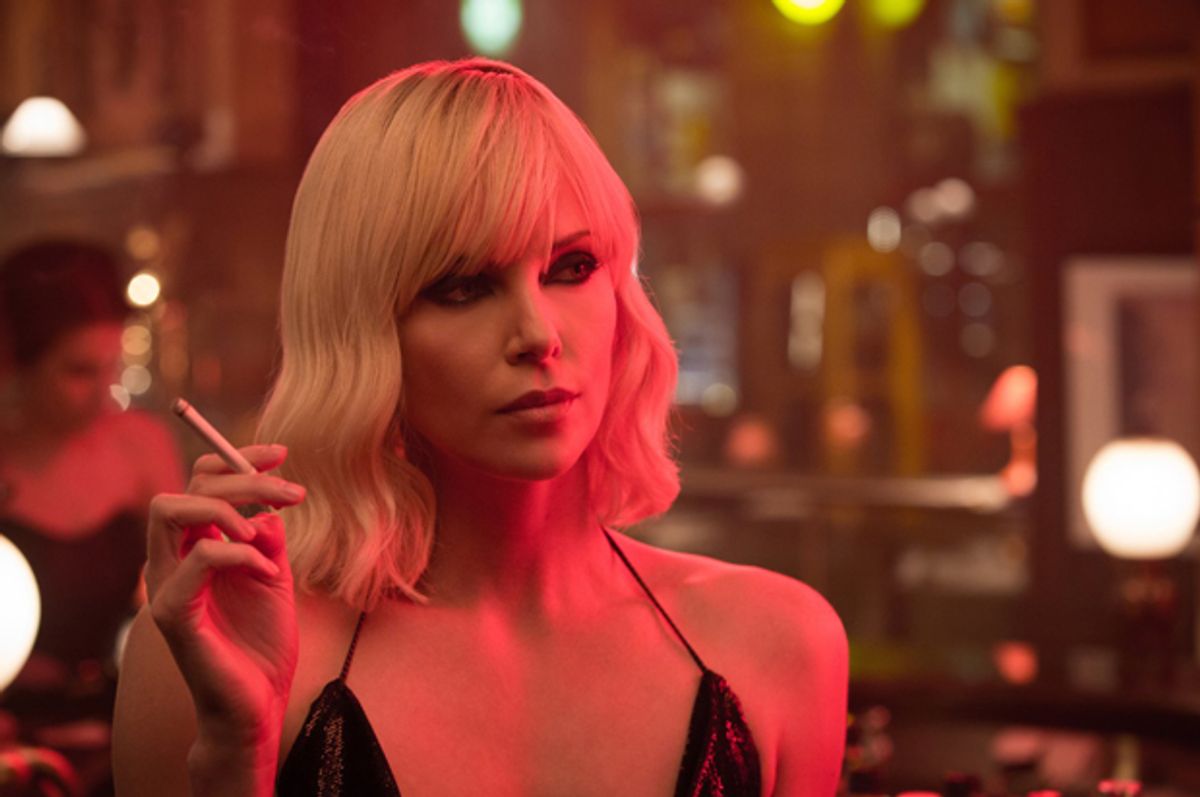In “Atomic Blonde,” David Leitch’s new Cold War-era spy thriller, Lorraine Broughton (Charlize Theron), the film’s MI6 agent heroine, does not so much appear as emerge: Her head rises out from under a layer of abstracted ice cubes — the dark lighting gives them the look of large chia seeds — and then her long, sinewy body follows. She climbs out of her bath as though she were a lab creation come to life.
And in a way, she is. Broughton is a character who is new to the screen — “Atomic Blonde” is an adaptation of Antony Johnston and Sam Hart's 2012 graphic novel “The Coldest City” — and as such is a nearly blank canvas. Leitch is not beholden to the details of familiar franchises, and he wastes no time coloring Johnston and Hart’s creation.
When Broughton stands up, we see that her face and body are flawlessly sculpted but made imperfect by a map of scratches and bruises: a shiner around her eye, a rupture on her lip, an isosceles angle on her back. Broughton pours herself a Stoli on the rocks, a drink which will become her trademark. She drinks her elegant drink roughly, the liquor splashing out of the glass when she pours it. Later, she’ll light a smoke, and when she inhales the rough tobacco she’ll do so elegantly. She is a woman of fine taste and unsentimental spirit. She dresses in stylish black and white outfits and often stains them red.
Though this introduction to Broughton works as a plot device — this is her at the end of the mission on which the story is based; she’ll tell us what happened in a briefing — it also works as a preemptive comment on Broughton’s relation to that one, big, inescapable spy influence. A spy, be they Bourne or Broughton, cannot drink a drink, bed a partner or shoot an enemy without a few unimaginative buggers drawing comparisons to Bond. So Leitch invites the parallel juxtaposition early, giving him the opportunity to subvert it later (though how he does so will have to remain classified). And at the same time, he hints that this new character has her own war stories.
Those war stories, which we soon witness, are every bit as epic as Bond’s, if not more so. Broughton’s mission involves flying to Berlin to investigate the murder of a colleague and to recover a missing list of double agents. But everything goes wrong. Broughton is sabotaged at every turn and she winds up fighting a diverse array of enemies (though most are big European men): KGB, German police, double agents, a lover. In each case, her opponent rues the day they crossed her. She fights fierce, nimble, and creative, puncturing faces with keys, outpunching large men and using necks to secure escape ropes.
Once the limb swinging and gun toting commences, you forget all about Bond. Or, I did, anyway. For others, “Atomic Blonde” has been cause to champion Charlize Theron as the next 007. (Chris Hemsworth made the case for Theron to W Magazine this week, inspiring chatter across the blogosphere.)
Indeed, “Atomic Blonde” is evidence that Theron would make as good a Bond as anyone: she’s pretty; she can believably convey top-notch combat skills and marksmanship; she can speak convincingly in a British accent; and she can simultaneously play cynical and vulnerable.
But “Atomic Blonde” is also a film that makes a female Bond seem inessential and comparatively boring. Lorraine Broughton does all the things James Bond does — swill alcohol, down villains and bed beautiful women — but she’s uninhibited by tradition. She has her own set of values, her own drink, her own adventures, and it’s all new to most audiences.
This is where I beg of the internet: Please, oh please, do not get me wrong. It wouldn’t bother me to see James Bond remade as a woman or as a minority. (If doing so makes either of those groups happy, I’m all for it!) But I have to ask (sincerely): Isn’t the point of making Bond a woman or a minority to bring about inclusive representation? Isn’t the underlying idea that white men shouldn’t be the only ones who are able to see themselves as super spies? And if so, doesn’t a film like “Atomic Blonde” achieve those things as well as a Jane Bond movie would?
It is vital that every moviegoer be able to see themselves as anything — be it a president, a spy, a superhero or the builder of a zoo. But is it essential that everyone be able to see themselves as everyone? Race and gender are essential components of identity, and subverting those qualities in iconic characters can send a powerful message if done with artistic purpose (see “Hamilton”). But at a certain point, a name is just a label. Casting James Bond as Jane Bond is only one step removed from renaming Jane Bond “Lorraine Broughton.” Is the middle step necessary? In 2017, isn’t Broughton — a fresh creation who is every bit as badass as James Bond but doesn’t possess his retrograde ideals — more interesting and exciting than Bond (James or Jane) anyway?
The malleability of fiction presents opportunities to reimagine classic characters. But the infinitude of fiction presents opportunities to imagine new characters so great they become canonically classic. The two things are not mutually exclusive. Lorraine Broughton can exist alongside Jane Bond. But it’s weird to think of Broughton as “a very happy compromise” or as Theron’s audition for the Bond role. The imagining of a new icon seems like it should be more exciting than the reimagining of an old one. But by all means, stop me if I begin to sound like a certain male villain in this film who says, “Women are always getting in the way of progress, aren’t they?”



Shares